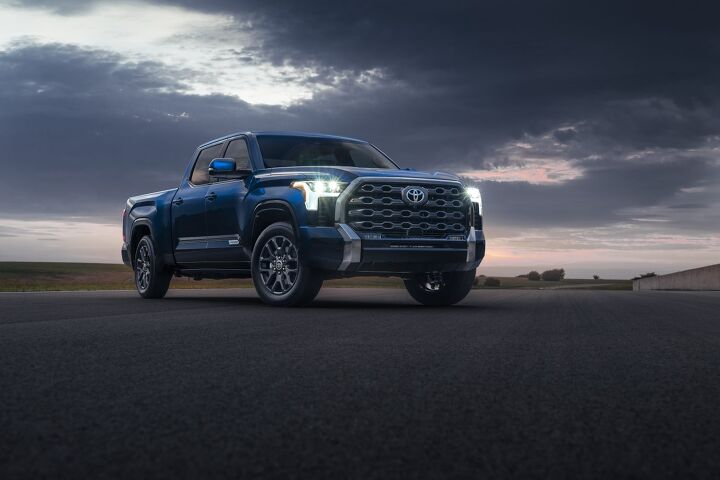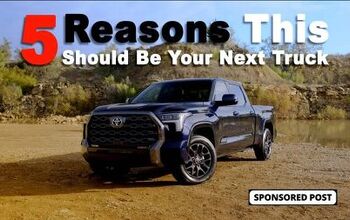2022 Toyota Tundra: We Ask Why

PONTIAC, MICH. — I noticed a couple of you commenters wondering why we hadn’t covered the 2022 Toyota Tundra yet.
One of you joked that we hadn’t done so because the grille is so ugly that we’d be charged with a crime.
The truth is more mundane than that — I was blindsided by its in-game reveal during Sunday Night Football and wasn’t in a position to write about it that night. And yesterday I was driving to suburban Detroit. One of the vehicles I was driving here to see: The Tundra.
So I figured I’d wait to see the truck in the flesh, so to speak. And now that I have, I have to ask — what is Toyota doing?
I am not just talking about the janky-looking grille, which looks less offensive to the eyes in person. There’s also the interior design, which looks at first glance to be carrying over the weird blocky look from the past.
Then there’s the fact that it apparently has a lower payload rating than the smaller Ford Ranger, at least in some trims.
What are we even doing here?
To be fair to Toyota, looks aren’t everything. Nor is a payload rating the only spec that matters. Maybe the truck is fantastic to drive and offers all the expected utility. But the early impressions are not great, Bob.
Here are the key specs — a standard twin-turbo 3.5-liter V6 makes 389 horsepower and 479 lb-ft of torque, and when equipped with a hybrid system that Toyota calls i-FORCE MAX, a bell-housing motor system boosts power to 437 horsepower and 583 lb-ft of torque. Either way, the transmission is a 10-speed automatic.
Towing capacity is listed at up to 12,000 pounds and a 14-inch infotainment screen is available, as is a 12.3-inch instrument screen. Toyota’s Safety Sense 2.5 driver-aid system is standard across the board. Max payload is 1,940 pounds.
Available features will include panoramic roof, heated and cooled front seats, heated steering wheel, towing aids, wireless Apple CarPlay and Android Auto, a tailgate release for the key fob, and over-the-air updates.
There will be two different four-door configurations and several bed lengths, including 5.5, 6.5, and 8.1 feet.
Toyota is using a fully boxed frame and promises more rigidity via high-strength steel while also using aluminum to reduce weight.
The suspension is multi-link with coil springs in the rear and the front is double wishbone. Twin-tube shocks front and rear are standard. Off-road trims get monotube Bilstein or FOX shocks. A rear air suspension is available on some trims. So, too, is an adaptive variable damping system.
Speaking of off-road, TRD Pro trims get a 1.1-inch front lift, front stabilizer bar, red-painted suspension parts, front skid plate, underbody armor, and all-terrain tires.
Available trim levels will be SR, SR5, Limited, Platinum, and 1794; with TRD Off-Road, Sport, and Pro packages being available.
The Tundra will go on sale later this year and be built in San Antonio, Texas. Pricing will be announced later.
Hopefully, we’ll have a good answer to what Toyota’s plan is by then.
[Images: Toyota, © 2021 Tim Healey/TTAC]

Tim Healey grew up around the auto-parts business and has always had a love for cars — his parents joke his first word was “‘Vette”. Despite this, he wanted to pursue a career in sports writing but he ended up falling semi-accidentally into the automotive-journalism industry, first at Consumer Guide Automotive and later at Web2Carz.com. He also worked as an industry analyst at Mintel Group and freelanced for About.com, CarFax, Vehix.com, High Gear Media, Torque News, FutureCar.com, Cars.com, among others, and of course Vertical Scope sites such as AutoGuide.com, Off-Road.com, and HybridCars.com. He’s an urbanite and as such, doesn’t need a daily driver, but if he had one, it would be compact, sporty, and have a manual transmission.
More by Tim Healey
Latest Car Reviews
Read moreLatest Product Reviews
Read moreRecent Comments
- Bkojote Allright, actual person who knows trucks here, the article gets it a bit wrong.First off, the Maverick is not at all comparable to a Tacoma just because they're both Hybrids. Or lemme be blunt, the butch-est non-hybrid Maverick Tremor is suitable for 2/10 difficulty trails, a Trailhunter is for about 5/10 or maybe 6/10, just about the upper end of any stock vehicle you're buying from the factory. Aside from a Sasquatch Bronco or Rubicon Jeep Wrangler you're looking at something you're towing back if you want more capability (or perhaps something you /wish/ you were towing back.)Now, where the real world difference should play out is on the trail, where a lot of low speed crawling usually saps efficiency, especially when loaded to the gills. Real world MPG from a 4Runner is about 12-13mpg, So if this loaded-with-overlander-catalog Trailhunter is still pulling in the 20's - or even 18-19, that's a massive improvement.
- Lou_BC "That’s expensive for a midsize pickup" All of the "offroad" midsize trucks fall in that 65k USD range. The ZR2 is probably the cheapest ( without Bison option).
- Lou_BC There are a few in my town. They come out on sunny days. I'd rather spend $29k on a square body Chevy
- Lou_BC I had a 2010 Ford F150 and 2010 Toyota Sienna. The F150 went through 3 sets of brakes and Sienna 2 sets. Similar mileage and 10 year span.4 sets tires on F150. Truck needed a set of rear shocks and front axle seals. The solenoid in the T-case was replaced under warranty. I replaced a "blend door motor" on heater. Sienna needed a water pump and heater blower both on warranty. One TSB then recall on spare tire cable. Has a limp mode due to an engine sensor failure. At 11 years old I had to replace clutch pack in rear diff F150. My ZR2 diesel at 55,000 km. Needs new tires. Duratrac's worn and chewed up. Needed front end alignment (1st time ever on any truck I've owned).Rear brakes worn out. Left pads were to metal. Chevy rear brakes don't like offroad. Weird "inside out" dents in a few spots rear fenders. Typically GM can't really build an offroad truck issue. They won't warranty. Has fender-well liners. Tore off one rear shock protector. Was cheaper to order from GM warehouse through parts supplier than through Chevy dealer. Lots of squeaks and rattles. Infotainment has crashed a few times. Seat heater modual was on recall. One of those post sale retrofit.Local dealer is horrific. If my son can't service or repair it, I'll drive 120 km to the next town. 1st and last Chevy. Love the drivetrain and suspension. Fit and finish mediocre. Dealer sucks.
- MaintenanceCosts You expect everything on Amazon and eBay to be fake, but it's a shame to see fake stuff on Summit Racing. Glad they pulled it.





































Comments
Join the conversation
If the truck manufacturers' could give a little more effort they could increase the size of the grills even more and offer 12" or more sized font in LED lighting on the grill and the tailgate. How about raising the height by at least another 6" to 12" and offer drop down ladders to enter the cab. Maybe widen the vehicles by at least another 6" and offer a front plate that says "Eat Me" (Animal House).
A 2021 (not 2022) Toyota Tundra has remarkably similar fuel economy to my 1995 C1500 [apples to apples, current methodology]: https://fueleconomy.gov/feg/Find.do?action=sbs&id=12210&id=43010 The 2021 Tundra of course is vastly more capable than my 20th century dinosaur, with significantly more torque and over twice the horsepower. (The Tundra also weighs roughly 35% more.) Perhaps I am the only truck owner on the planet who would have preferred to see a somewhat smaller bump up in horsepower and torque over 2-1/2 decades, combined with a significant improvement in fuel economy. (Perhaps the polar bears would side with me, but who is listening.) Toyota may be taking steps in the right direction with the 2022 model - will withhold judgment until the 2022 fuel economy [and curb weight] figures are published.